The Offbeat Sari at the Design Museum – Review
September 23, 2023I confess I have been slow on the uptake for this beautiful, thought-provoking exhibition. A few months ago there were no new fashion exhibitions on in London and now I have an embarrassment of choices. I hope you can make this one too, it closes soon, on 17th September. Although it is called “The Offbeat Sari“, the show covers a little history, a little tradition, a snippet of making techniques and examples of beautiful everyday style as well as show stoppers and saris worn in unusual situations such as – heart-in-mouth moment – for rock climbing.
The Offbeat Sari – revitalising the form
In essence, a sari is a length of material. As such, of course it has near-infinite possibilities for decoration, fabric types and weight, according to the wearer’s preference, the climate and the designer’s ideas. But over time, of course, these settle into traditional designs and colours, and what people unused to the garment or region might see as beautiful, glowing and colourful, others might regard as dowdy, boring, and something a frumpy older relative might wear without much thought as to its aesthetic impact.
Alternatively, it feels too restrictive and fancy. Much like the kimono in Japan, the sari has come to be seen as something worn on formal occasions – beautiful but rather archaic. And so there are design houses who have come along to revitalise the form and make it cool again. The exhibition shows work by design houses like Abraham & Thakore, Raw Mango, Akaaro and NorBlackNorWhite. The pieces play with colour in an unexpected way, and are styled with trainers and athletic wear.
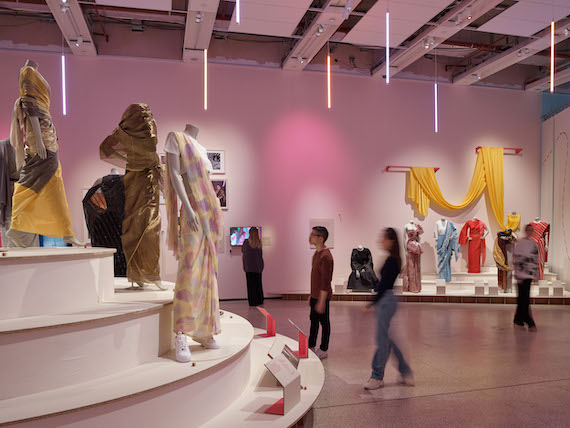
Installation view of the Offbeat Sari © Andy Stagg for the Design Museum, used with permission.
More Avant-Garde
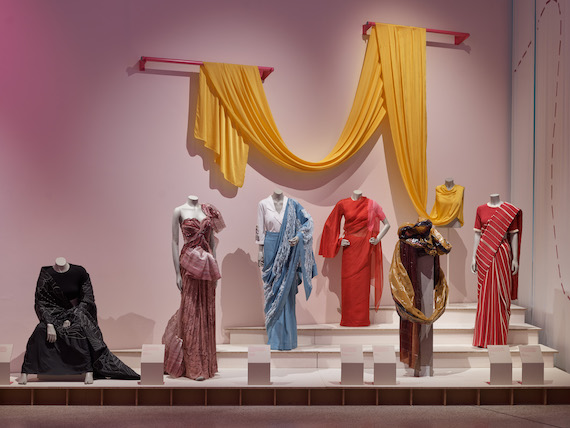
Installation view of the Offbeat Sari © Andy Stagg for the Design Museum, used with permission.
There are also designers who have taken the idea of the sari and run with it, to create pieces that are more like artworks. For example, a resin-soaked sari, converting its essential fluidity into something hard and immutable. There is one made from woven steel.
Also shown are saris made from faded, distressed denim, crossing the boundaries between Western wear, exemplified by denim jeans, and traditional fabrics. Another, very attractive piece, uses a plain black jersey crop top, a simple black skirt, and a lightly padded black wrap, quilted in white thread. This monochrome ensemble is in contrast to the colourful saris we are used to seeing, and almost doesn’t read as one, yet it contains its essential elements.
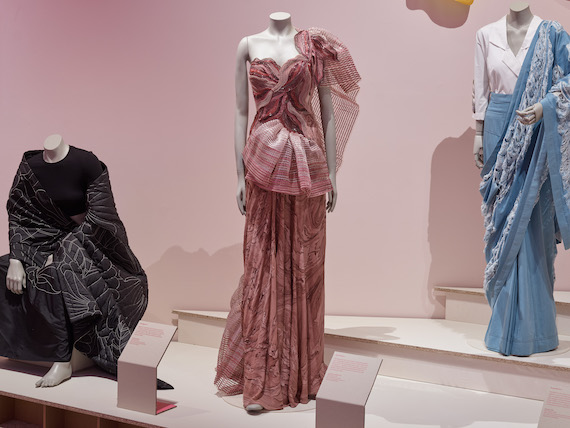
Installation view of the Offbeat Sari © Andy Stagg for the Design Museum, used with permission.
The Many Ways of Wearing a Sari
There is a beautiful wall of images taken mostly from Insta of the elegance of people who have interpreted the sari in their own way. Often it will be with an unusual colour scheme, such as silver-grey, or they swap the traditional crop top worn beneath the fabric wrap for a different kind of top to make a completely different effect.
I was hypnotised by the videos showing different ways to tie and wear a sari. The most familiar sight in Britain is probably the Nivi Drape. But it make sense that there are other ways to do it. As a western dress has many forms, so does the sari. There is even a tying technique which divides it between the leg. It renders it a bit like harem pants, loose trousers secured tightly at the calf and ankle. Others involve very neat pleating, measured by hand’s widths and surely second nature to the every day wearer. But absolutely fascinating to watch in its dexterity.
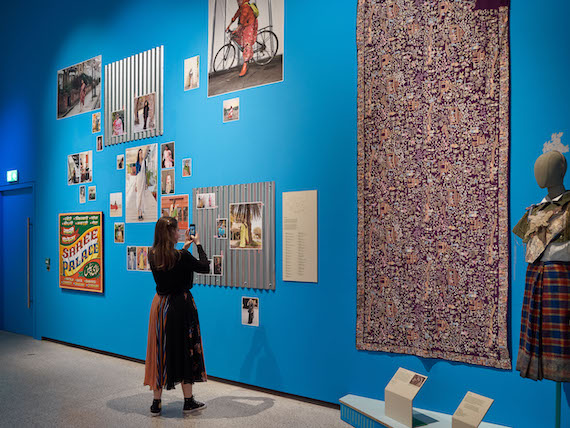
View of the Offbeat Sari © Andy Stagg for the Design Museum, used with permission.
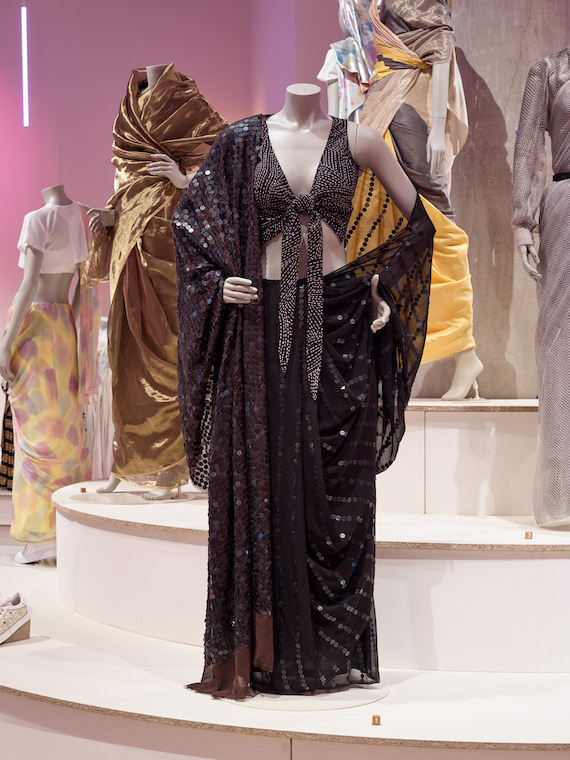
Installation view of the Offbeat Sari © Andy Stagg for the Design Museum, used with permission.
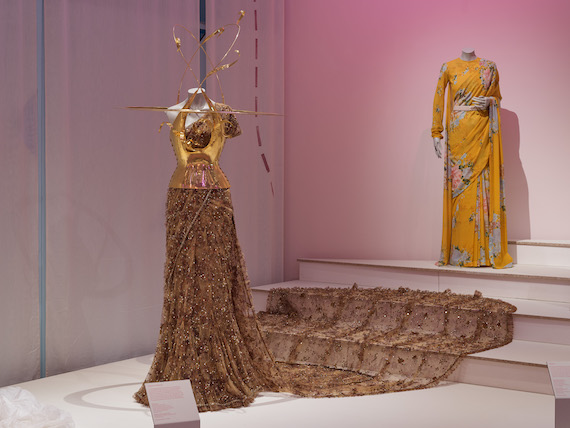
Schiaparelli bodice at the Offbeat Sari © Andy Stagg for the Design Museum, used with permission.
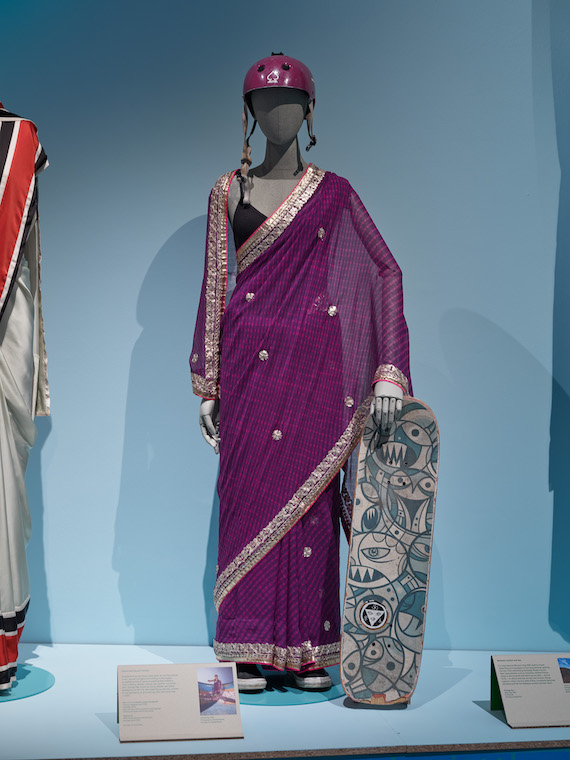
Installation view of the Offbeat Sari © Andy Stagg for the Design Museum, used with permission.
The Offbeat Sari – Used as a Protest
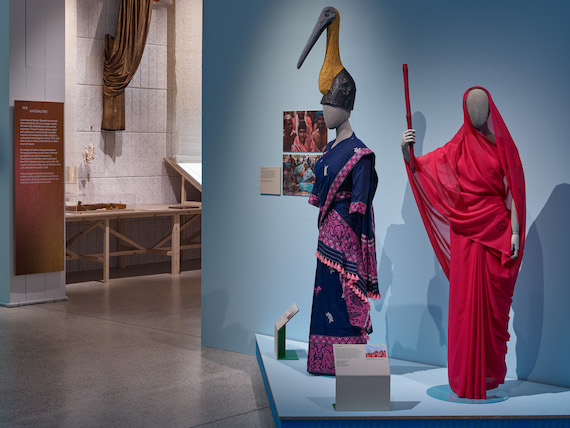
Installation view of the Offbeat Sari © Andy Stagg for the Design Museum, used with permission.
Look at this incredible all-pink sari. It is an ensemble worn by a member of the Gulabi Gang, the group of women who protect other women in India. The uniform is loose, but generally they are identifiable by their hot pink sari and matching hot pink lathi, or wooden stick. Gulabi means pink in Hindi. The group numbers more than a quarter of a million women. They use both violent and non-violent means to combat the endemic problems of female inequality in India. These have many aspects, including child marriage, low rates of female literacy, and domestic and sexual violence. In joining together these women have made a huge difference in their own and many other people’s lives. Many have been elected to political office.
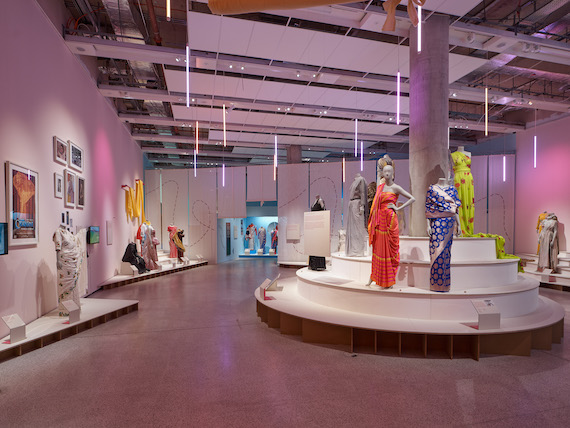
Installation view of the Offbeat Sari © Andy Stagg for the Design Museum, used with permission.
The Glamorous Sari
For lovers of all out glamour, there are several beautifully produced and envisaged pieces. Many of these come in the form of pre-draped saris, where the folds are made by dressmakers and stitched down, so they can be slipped into more easily. They have extravagant ruffles or are styled with outsized beaded collars. One, which was worn at the Met Gala, is completely overshadowed by the Schiaparelli gold bodice worn on top. In my opinion they don’t exactly go well together either. Which is a shame as it was the first ever sari to be worn at the Met Gala, in 2022.
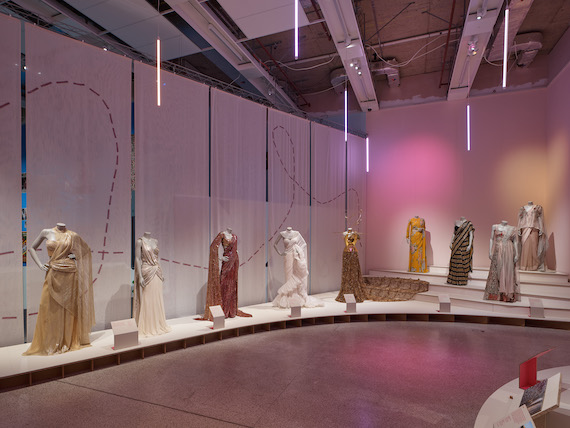
Installation view of the Offbeat Sari © Andy Stagg for the Design Museum, used with permission.
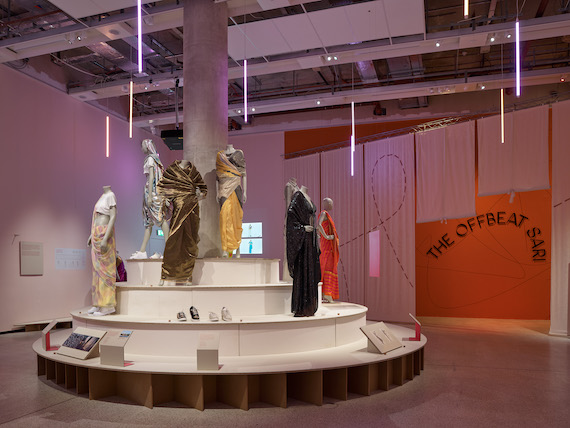
Installation view of the Offbeat Sari © Andy Stagg for the Design Museum, used with permission.
The curator and the exhibition team are to be commended. They are Priya Khanchandani, Head of Curatorial at the Design Museum, Rashmi Varma, associate curator, Tiya Dahyabhai, assistant curator, Studio Mutt, 3D design, Stuthi Ramesh, 2D design.
The Offbeat Sari was on at the Design Museum on Kensington High Street until 17th September.


